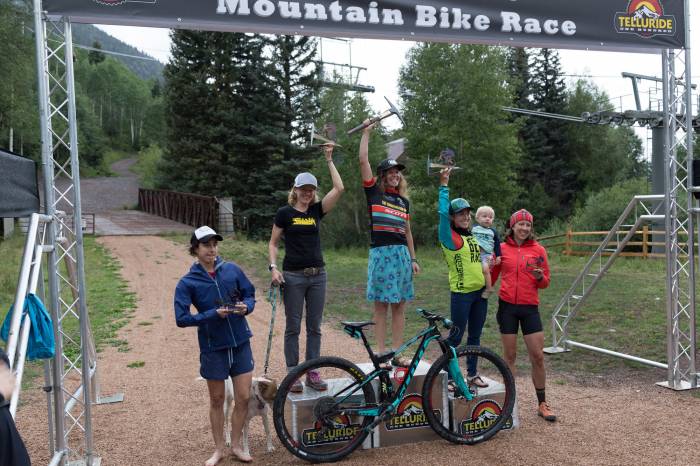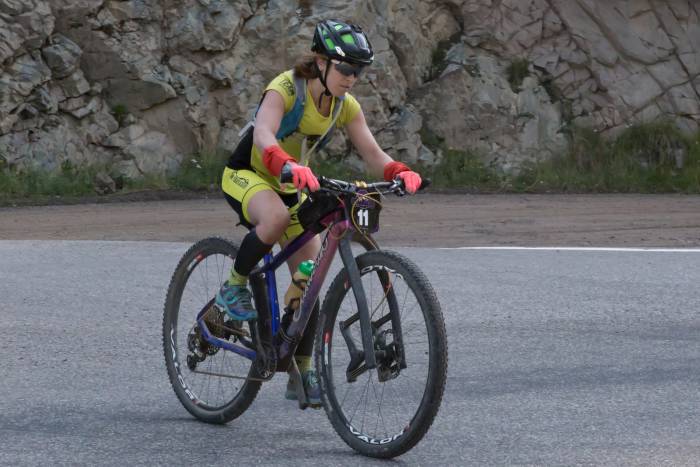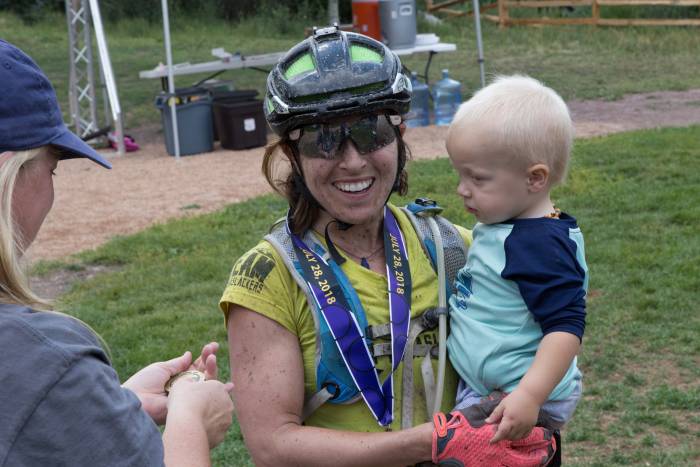The 100-mile distance is certainly on the “ultra” edge of the endurance mountain biking spectrum. But a reasonably fit rider, training eight hours per week for 25 miles at a time, can prepare in about a month. Here’s how.
Pedaling 100 miles over washboard bumps, mountain passes, and tire-swallowing sand patches probably seems like a death march.
But tackling a 100-mile race on a mountain bike, though certainly difficult, is not impossible. In fact, given a base level of fitness and athletic ability, you can whip yourself into race-day shape in about a month. Don’t believe me? Check out the tips below and try it out!
As a general rule, before taking on a 100-mile race, you should be able to ride about 35 miles two to three times per week without feeling exhausted. And if your goal is not performance but simply to finish, you have even more leeway.
At the very least, I recommend riding 25 miles at a time to condition your bum to be on the bike.
Do Your Research
With many races I do, the course is kept secret until the night before the race. But information on almost all mountain bike race courses is out there, so do your homework.
A quick Google search will usually return official race maps, course elevation, and even other athletes Strava data. Try to gather complete info, including elevation gains and losses, and percentages of singletrack and road riding.
To go a step further, I even looked up a few different reports on the races. This provided people’s perspectives on the climbs, terrain, and overall feel of the course. And it gave me a better idea what I was in for and what to focus on training-wise.
Make a Plan, Get a Coach
The best way to feel prepared for a 100-mile race is to make and stick to a plan. Or better yet, get someone to coach you. A training program lets you break the training and race into bite-size pieces so you’re not overwhelmed by the larger picture.
For example, leading up to the Telluride 100, I trained three times per week. I worked on hill climb repeats, endurance efforts, and singletrack descent speed, as I knew all of those constituted big components of the race.
I also highly recommend working with a coach. When you’re deep in training, you don’t always have the best perspective on what’s working. Throughout my athletic career, having that outside eye from a coach I trust has been huge.
And with many online coaches available for around $100-200 per month, it’s worth the investment. And given you might spend nearly $600 on the race entry, travel, and lodging (like I did), it proves money well spent to feel prepared.
How to Choose an MTB Race Coach
When choosing a coach, make sure you’re familiar and agree with their training methodology and philosophies. Relating to them on this level will help you trust them when you feel like it’s not working. (This always happens!)
There are many fake coaches out there, especially online. So do your homework, interview them, and make sure you feel good about committing to them. Also remember: Coaches are not there to make you do your training or constantly check up on you. Ultimately, it is you who has to choose to do your work. Your coaches can only do so much.
I recommend choosing a coach specializing in low-volume, higher-intensity training. It’s easier to commit to five to 10 hours per week than a classic high-volume training of 20-30 hours each week.
Allow Yourself At Least 4-5 Weeks to Train
Out of all the 100-mile mountain bike races, those where I felt the best were when I committed myself to at least four weeks of focused training. Experts like Joe Friel (“The Triathlete’s Training Bible“) and Vladimir Issurin (“Block Periodization“) agree a four- to five-week training block is the most effective in keeping athletes engaged, injury free, and peaking for race day.
Mentally, this period gives athletes time to experience and work through highs and lows in their training, which teaches them valuable lessons that will surely repeat during race day. That said, four weeks is not enough to build a base. A 25-mile ride is a big stretch, add another month to build to a 25-mile base before starting the month-long block leading up to your race.
Rest Days Are Mandatory
As I started pushing my body harder and harder, I found a direct correlation between rest and output. The more I recovered, the better I would perform on training days. And by rest and recovery, I don’t mean just lying on the couch and watching Netflix.
Active recovery means drinking a ton of water, stretching, getting a massage, doing physical therapy, rolling out your muscles, and, if you have access to them, sitting with your legs in compression sleeves. During my training block, I gave myself one full day of active recovery and then two days of recreational recovery.
Coming into Telluride, I could do just about anything on rest days with the caveat of keeping my heart rate below 140. Leading up to the race, I gave myself two full rest days that included two 30-minute spinouts just to get the blood moving.
These days, my favorite recovery tools are Crossover Symmetry for my shoulders, Marc Pro for getting blood flow into my ligaments to prevent injuries, Air Relax Compression Sleeves, and any of the RAD roller tools.
Nutrition
Nutrition is different for everyone. Some racers eat nothing but Doritos and Snickers for an entire four-day race and dominate the entire time. Others are careful and clean about what they eat, only to get gut troubles or bonk unexpectedly.
As a general rule, I eat 150 calories per hour during my activities. And my calories come from a variety of foods depending on what I’m doing. For biking, I mostly drink my calories. Lately, my favorite foods for on the bike are Laird Superfood Tumeric Coconut Water, a friend’s secret handmade maltodextrin magic mix, and Tailwind Nutrition.
The cheap gummy snacks that go in kids’ lunches are perfect for quick bites too — and cheap! For hot races, I keep Elete handy for a quick salt hit. For before and after the race, I’m a big fan of protein smoothies. Paleo Pro makes my absolute favorites, as all of its ingredients are legit and clean.
No matter what nutrition plan you use, test it out on all of your training rides, in all types of conditions, so you know what works for you and what doesn’t.
Pro tip: Always have a little something at the bottom of your pack or bento box for emergencies, or when the thought of another bite of what you are used to makes you nauseous. It will happen!
Get Mountain Bike Gear That Will Last
Century races are very different from your average 25- to 45-mile bike races. In the shorter races, you can easily get away with a bike seat or chamois that doesn’t feel all that great after mile 50. But for the long haul, you need to look for a bike seat and chamois combo that’s intended for long rides.
My all-time favorite bike seat is the Ergon Women’s Gel SM seat, as it has a relief hole for sensitive areas and a little extra padding for my sit bones. However, most good saddles have this, so it really depends on what feels good to you.
For chamois, choose one that you know and like. My advice is to splurge here. My go-to shorts are the 2XU Compression Cycle Shorts.
Yet another consideration should be handlebars grips. I’m a big fan of Ergon grips, as they’re ergonomic and support your natural wrist angle. But again, no matter what you choose, make sure you test it out a number of times before race day on all sorts of rides, especially your longer endurance days!
Race Day: Set Specific, Tangible Goals
If you don’t set goals, then how will you ever measure your success? Setting goals doesn’t have to be stressful. Instead, think of your goals as things to strive for or to keep your mind occupied during the race.
Before I start a race, I always set a time goal and a feeling goal. For example, for the Telluride 100, I set out with the goal to beat my previous year’s time by at least 30 minutes and to constantly find ways to eek out a 1 percent faster riding rate.
Throughout the race, I was constantly checking on it and working hard to beat it or at least match it. Doing this helped me “race my own race” and not worry about who was ahead of or behind me.
For newer racers, when you don’t have a prior performance to work off of, consider other goals. It might be more appropriate to set expectations related to eating, drinking, perspective, or quitting. For my first 100-miler, these were my goals:
1. Drink at least one sip every 15 minutes. I set a little alarm to go off repeatedly, and it was a great way to stay hydrated.
2. Eat every hour. Sometimes I’d eat more, and I’d allow myself a short two-minute stop if needed. This little luxury can keep the doldrums at bay.
3. Look around. Every time I’d eat or drink, I reminded myself to observe my surroundings. Hundred-milers tend to traverse stunningly beautiful places. Make it a point to see them.
4. Quitting. I gave myself permission to quit, but not in the moment. If I wanted to drop out, it’s my rule that I have to make it one aid station past where I make the decision.
For example, if I’m miserable when arriving at an aid station and want to quit, I must continue riding to the next station before I actually abandon the race. I’ve used this method in races from six hours to six days, and it’s always led me to the finish line.
But if I do quit, I’m also committed to not berating myself later. Life is too short to be continuously miserable for too long. And endurance racing is too hard to expect to not be totally miserable for at least some of the time.
Be Curious, Trust the Process
If you’re anything like me on race day, hopefully you’ll have the pre-race jitters. Don’t worry: This is good and natural!
Twenty minutes into the race, rest assured you’ll settle into your pace and maybe even enjoy yourself a little bit. My coach and husband gave me the most helpful advice I’ve ever received: “trust your training” and “be curious about how much faster and farther you can go.”
These two gems have helped me through some rough times in almost every race I have entered. Because, if you’re truly pushing yourself, you’re bound to hit your edges and visit the pain cave a few times. But it’s how you deal with it that counts.
In the Telluride 100, I was ready to turn around in the middle of the first climb because I thought I wasn’t strong enough. But then I reminded myself to simply “be curious,” and I asked myself, “How will you feel once you get to the top?”
And once I got to the top, I felt better. So I just kept asking myself the same question until 10 hours later, when I crossed the finish line.
Chelsey Magness finished third in the Women’s Elite division, only 15 minutes behind the winner.
You can View Chelsey’s Telluride 100 race report here.










